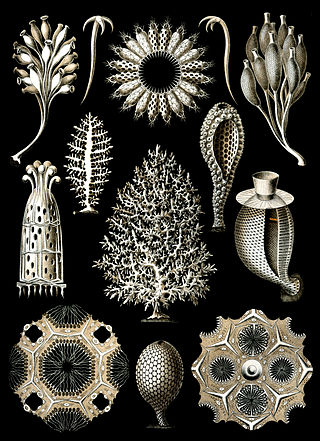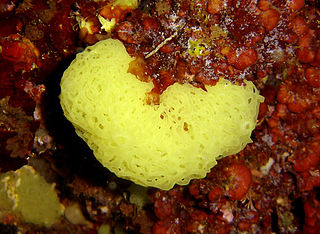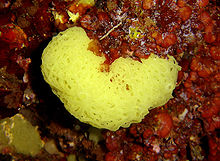
The calcareoussponges are members of the animal phylum Porifera, the cellular sponges. They are characterized by spicules made of calcium carbonate, in the form of high-magnesium calcite or aragonite. While the spicules in most species are triradiate, some species may possess two- or four-pointed spicules. Unlike other sponges, calcareans lack microscleres, tiny spicules which reinforce the flesh. In addition, their spicules develop from the outside-in, mineralizing within a hollow organic sheath.

Clathrina is a genus of calcareous sponge in the family Clathrinidae. Several species formerly in Clathrina were transferred to the newly erected genera Arturia, Ernstia, Borojevia, and Brattegardia in 2013. The name is derived from the Latin word "clathratus" meaning "latticed".

Clathrus ruber is a species of fungus in the family Phallaceae, and the type species of the genus Clathrus. It is commonly known as the latticed stinkhorn, the basket stinkhorn, or the red cage, alluding to the striking fruit bodies that are shaped somewhat like a round or oval hollow sphere with interlaced or latticed branches. The species was illustrated in the scientific literature during the 16th century, but was not officially described until 1729.
Clathrina aurea is a species of calcareous sponge from Brazil. Specimens of this species were previously misidentified with Clathrina clathrus
Clathrina blanca is a species of Calcareous sponge in the genus Clathrina.
Clathrina ceylonensis is a species of calcareous sponge from Sri Lanka. The species name is derived from Ceylon, the former name of Sri Lanka.
Clathrina chrysea is a species of calcareous sponge from New Caledonia. The species epithet refers to the light yellow colour of the sponge.
Clathrina clara is a species of calcareous sponge from India. The name refers to the clear, bright surface of the sponge.
Ascandra contorta is a species of calcareous sponge belonging to the family Clathrinidae.

Clathrina coriacea is a species of calcareous sponge belonging to the class Calcarea and family Clathrinidae. Species in the genus Clathrina are composed of calcium carbonate tube-like skeletons containing spicules. The sponge can be located in shallow waters widely distributed along North Atlantic coasts, as well as on other coasts.
Clathrina cribrata is a species of calcareous sponge in the family Clathrinidae. The holotype was collected from Kristiansund, Norway.
Clathrina cylindractina is a species of calcareous sponge from Brazil. The species is named after the cylindrical-shaped actines the sponge possesses.
Clathrina laminoclathrata is a species of calcareous sponge from Australia. The species name is in reference to its unusual lamina.

Clathrina lacunosa is a species of calcareous sponge from the British Isles. The species name means "having holes" and refers to the perforations found in the sides of the sponge. It is usually found on vertical solid surfaces at depths down to 220 m. It is distributed in the north-eastern Atlantic from the Arctic to the Mediterranean. It is a fairly common sponge but is often overlooked due to its small size.
Clathrina mutsu is a species of calcareous sponge from Japan. The species is named after the type locality, Mutsu Bay
Clathrina sulphurea is an unaccepted scientific name and may refer to three species of calcareous sponge:
Aegires evorae is a species of sea slug, a nudibranch, a marine, opisthobranch gastropod mollusc in the family Aegiridae.
Aegires sublaevis is a species of sea slug, a nudibranch, a marine, opisthobranch gastropod mollusk in the family Aegiridae.





